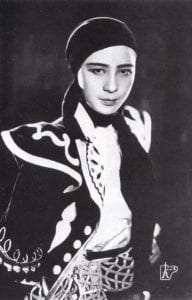
Some celebrities in Japan have been holding a “seizenso,” which translates to a “funeral while alive” — motivating everyday citizens to do the same. More recently, the practice of living funerals has spread to South Korea, the U.S., Europe and beyond.

Takiko Mizunoe held the first
seizenso in 1992.
The first seizenso was held by Japanese singer and actress Takiko Mizunoe in 1992 and was broadcast on television to great fanfare, according to “Death and Dying in Contemporary Japan,” a book edited by Hikaru Suzuki. “I wanted to express my appreciation to all those who have been dear to me while I am still alive,” Mizunoe said at the time.
The funeral involved traditional practices, such as burning incense and memorial speeches, while also incorporating Buddhist sutras, Chopin’s “Funeral March,” Mozart’s “Requiem” and even Christmas carols. At the finale, “Santa Claus is Coming to Town,” the funeral converted into a party. Afterward, Mizunoe told its organizer, songwriter Rokusuke Ei, who described the funeral in his book “Daiojo” (which has been translated as “Happy Ending” or “Dying Peacefully”): “You should die too. It’s a glorious morning after death!”
Confronted with an increasingly negative view of aging, elderly people in Japan use the practice to celebrate their “agency, self-sufficiency and personal pleasure in steering their remaining years,” Satsuki Kawano wrote in the journal Ethnology.
South Korean Living Funerals Take More Serious Approach
Meanwhile, in South Korea, tens of thousands of people have participated in living funeral services for a different reason: to contemplate death in order to improve their lives. Hyowon Healing Center, which opened in 2012, offers mass ceremonies that encourage people to appreciate life, seek forgiveness and find reconciliation.
Participants wear burial shrouds, write their last testament and lay in a closed coffin for about ten minutes. In other programs, such as one called “Happy Dying,” participants have their hands bound and eyes covered. To offset the nation’s high suicide rate, some companies even require their employees to attend.
“Once you become conscious of death, and experience it, you undertake a new approach to life,” 75-year-old Cho Jae-hee told Reuters after participating in a program through her senior welfare center.
Western Countries Embrace Living Funerals
The practice of living funerals has since spread to the West, with both the life-celebration and death-contemplation varieties taking hold. Guided meditation classes offer opportunities to explore one’s mortality, while organizations and books assist people in commemorating their lives.
Amanda Waring held what she considers a living funeral for her mother, actress Dorothy Tutin, by setting up an honorific TV appearance on the show “This is Your Life.” Waring, who has participated in living funerals in hospice, outdoors, and in a large ballroom, said that ceremonies can involve blessing individual parts of the person’s body, or gratitude circles, in which everyone shares what they appreciate about someone.
In Scotland, some comedians have even held a sort of living funeral onstage — allowing them to quite literally have the last laugh. Myra Dubois performed a show at the Edinburgh Fringe titled “Dead Funny,” during which audience members could stand up and say what she meant to them. “I’ll get me a bit of that!” she thought after attending several funerals.

 Living Funerals, or Seizenso, Are Gaining Popularity
Living Funerals, or Seizenso, Are Gaining Popularity


 How Dare You Die Now!
How Dare You Die Now!
 Debating Medical Aid in Dying
Debating Medical Aid in Dying
 “Help Me, Helen”
“Help Me, Helen”














